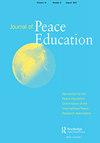Migration, cultural encounters and (Peace) education
IF 1.3
Q3 EDUCATION & EDUCATIONAL RESEARCH
引用次数: 0
Abstract
This issue of the Journal of Peace Education is a special edition focusing on three interconnected topics: migration, cultural encounters, and peace education. Even though migration has been a continuous and integrated part of human history at all times, it increases in certain periods. We are living in such a period. The causes of migration are not the topic of this special issue. The focus is on cultural encounters that follow from migration, and conflict that may emerge when migration increases rapidly, or comes in waves. However, cultural conflict often follows in the wake of attempts by states or majority nations to subdue indigenous peoples or make them disappear through a process of cultural marginalization or assimilation. This issue of the journal covers both these phenomena. The idea that education can promote cooperation and friendship across ethnic or other group boundaries, is essential in peace education, and has long roots in peace education and social psychology (Allport 1954; Aronson and Bridgeman 1979; Gaertner et al. 2000; Sherif 1988; Watson 2008; Watson and Huá 2016; Zhu, Jiang, and Watson 2011). However, some of these ideas, inter alia Aronson and Bridgeman’s ‘Jigsaw Classroom’, have been met with criticism that the ideas do not take adequately into account the context of intergroup encounters, and which contextual conditions must be met to facilitate the goals of inter-group cooperation and friendship (Bratt 2008; Salomon 2006) and details as regards teaching methods and composition of the group of learners (e.g. Nusrath et al. 2019, table/fig-4; Salomon 2004). Educational efforts to increase tolerance, cooperation and integration of people belonging to different cultural groups or communities have no success formula or guarantee of success. Cultural encounters demand work to learn to know and understand one another’s customs, norms, cultural values, ideals and taboos. Without such knowledge and attitudes, mutual tolerance and respect is difficult, if not impossible. But even though such knowledge and attitudes are internalized in most people of a society, we need to integrate groups on a practical, social level, because inter-group boundaries do not disappear just because people understand one another. The complexity and difficulty of the task may be underestimated in peace education projects. Individuals and/or groups that move across borders have been involved in a long process of socialization into one or more cultures before they moved. They have acquired an identity based on that former socialization, and the territory, community or nation they leave, are part of their identity. So in JOURNAL OF PEACE EDUCATION 2023, VOL. 20, NO. 2, 127–134 https://doi.org/10.1080/17400201.2023.2241722移民、文化交流和(和平)教育
本期《和平教育杂志》是一期特刊,重点关注三个相互关联的主题:移民、文化遭遇和和平教育。尽管移民在任何时候都是人类历史上持续而完整的一部分,但在某些时期,移民数量还会增加。我们生活在这样一个时期。移民的原因不是本期特刊的主题。重点是移民带来的文化遭遇,以及移民迅速增加或一波接一波时可能出现的冲突。然而,文化冲突往往是在国家或多数民族试图通过文化边缘化或同化过程来征服土著人民或使他们消失之后发生的。这期杂志涵盖了这两种现象。教育可以促进跨越种族或其他群体界限的合作与友谊,这一观点在和平教育中至关重要,并且在和平教育和社会心理学中有着悠久的渊源(Allport 1954;Aronson和Bridgeman 1979;Gaertner等人2000;Sherif 1988;Watson 2008;Watson和Huá2016;朱、江和Watson 2011)。然而,其中一些想法,特别是Aronson和Bridgeman的“竖锯课堂”,遭到了批评,认为这些想法没有充分考虑到群体间相遇的背景,以及必须满足哪些情境条件才能促进群体间合作和友谊的目标(Bratt 2008;所罗门,2006年),以及关于教学方法和学习者群体组成的细节(例如Nusrath等人,2019,表/图4;所罗门,2004年)。为增进属于不同文化群体或社区的人的宽容、合作和融合所做的教育努力没有成功的公式或成功的保证。文化接触需要工作来学习了解和理解彼此的习俗、规范、文化价值观、理想和禁忌。如果没有这些知识和态度,相互宽容和尊重即使不是不可能,也是很困难的。但是,即使这种知识和态度在社会的大多数人中都已内化,我们也需要在实际的社会层面上整合群体,因为群体间的界限不会因为人们相互理解而消失。和平教育项目可能低估了这项任务的复杂性和难度。跨境流动的个人和/或群体在流动之前,已经参与了一个或多个文化的长期社会化过程。他们在以前的社会化基础上获得了一种身份,他们离开的领土、社区或国家是他们身份的一部分。因此,在《和平教育杂志2023》第20卷第2期第127–134页https://doi.org/10.1080/17400201.2023.2241722
本文章由计算机程序翻译,如有差异,请以英文原文为准。
求助全文
约1分钟内获得全文
求助全文

 求助内容:
求助内容: 应助结果提醒方式:
应助结果提醒方式:


